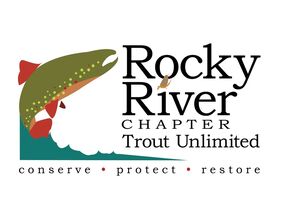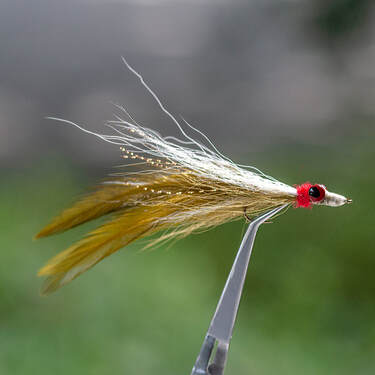Fly of the Month 09.20
Lefty Kreh and Bob Clouser became best of friends and icons of fly fishing. Unfortunately, we lost Lefty to the great stream in heaven only recently. Bob continues to be in the public eye at fly fishing shows and continues to contribute to the evolution of fly fishing. Lefty originated and developed the Lefty Deceiver, a universal baitfish streamer used primarily in saltwater but adapted for use in any body of water. Bob Clouser originated and developed the Clouser Minnow, a universal baitfish streamer used primarily in Warmwater but adapted for use in any body of water as well
Half & Half Streamer
Of course, as friends, it did not take long until they were trying fly patterns that provided the best of both the deceiver and the clouser. Thus, the Half & Half Streamer was created from two remarkable fly patterns creating to become the third universal baitfish streamer available for we anglers to use to fool fish. Clouser fly patterns utilize dumbbell eyes for weight and to turn the hook upside down to prevent any bottom snagging. Bucktails and synthetic hair are the primary materials for the body. Add the feathers from the deceiver to increase the bulk, motion and visibility of the fly pattern and you now have a half deceiver and half clouser, a Half & Half streamer.
If you have noticed the huge number of color combinations that are tied or available for both the clouser and the deceiver, then it is easy to imagine all the possibilities for the half & half design. Prominent color patterns include but are not limited to: Black, Foxee Dace, Golden Shiner, Silver Shiner, Blue/White, Chartreuse/White, Gray/White, Green/White, Red/White, Red/Yellow and White.
The one downside to this fly pattern – it takes a little longer to tie than either of the “parent” fly patterns.
If you do not fly fish in saltwater, you should. However, until you do keep in mind that is fly pattern attracts large fish anywhere – streams, ponds and lakes are all places to fish fly patterns that imitate or suggest baitfish.
Half & Half Streamer
Fly of the Month 09.20
Tom Adams and Alen Baker
References:
Internet; Jack McNeary RRTU Beginner’s Fly Tying Class
Half and Half Recipe
HOOK : Streamer Daiichi 2200 4x or equivalent, size 10,8,6,4
Thread : 140 d UTC white
Eyes : Dumbell in red
Body : Olive Strung Saddle hackle or any color of choice with crystal flash
Body Top : White Bucktail
Body Bottom : Olive Bucktail
Collar : Red seal or equivalent
Directions :
Lefty Kreh and Bob Clouser became best of friends and icons of fly fishing. Unfortunately, we lost Lefty to the great stream in heaven only recently. Bob continues to be in the public eye at fly fishing shows and continues to contribute to the evolution of fly fishing. Lefty originated and developed the Lefty Deceiver, a universal baitfish streamer used primarily in saltwater but adapted for use in any body of water. Bob Clouser originated and developed the Clouser Minnow, a universal baitfish streamer used primarily in Warmwater but adapted for use in any body of water as well
Half & Half Streamer
Of course, as friends, it did not take long until they were trying fly patterns that provided the best of both the deceiver and the clouser. Thus, the Half & Half Streamer was created from two remarkable fly patterns creating to become the third universal baitfish streamer available for we anglers to use to fool fish. Clouser fly patterns utilize dumbbell eyes for weight and to turn the hook upside down to prevent any bottom snagging. Bucktails and synthetic hair are the primary materials for the body. Add the feathers from the deceiver to increase the bulk, motion and visibility of the fly pattern and you now have a half deceiver and half clouser, a Half & Half streamer.
If you have noticed the huge number of color combinations that are tied or available for both the clouser and the deceiver, then it is easy to imagine all the possibilities for the half & half design. Prominent color patterns include but are not limited to: Black, Foxee Dace, Golden Shiner, Silver Shiner, Blue/White, Chartreuse/White, Gray/White, Green/White, Red/White, Red/Yellow and White.
The one downside to this fly pattern – it takes a little longer to tie than either of the “parent” fly patterns.
If you do not fly fish in saltwater, you should. However, until you do keep in mind that is fly pattern attracts large fish anywhere – streams, ponds and lakes are all places to fish fly patterns that imitate or suggest baitfish.
Half & Half Streamer
Fly of the Month 09.20
Tom Adams and Alen Baker
References:
Internet; Jack McNeary RRTU Beginner’s Fly Tying Class
Half and Half Recipe
HOOK : Streamer Daiichi 2200 4x or equivalent, size 10,8,6,4
Thread : 140 d UTC white
Eyes : Dumbell in red
Body : Olive Strung Saddle hackle or any color of choice with crystal flash
Body Top : White Bucktail
Body Bottom : Olive Bucktail
Collar : Red seal or equivalent
Directions :
- Begin thread wraps four or five eye lengths back from eye and wrap tightly about one third of the length. Let the bobbin hang
- Holding the dumbbell eye with your left hand make three or four x wraps to position it on top of the hook shank. Once you are happy with the position make three more x wraps and then make two or three firm wraps under the eye where it contacts the shank binding the x wraps tight to the dumbbell. Continue with three more x wraps as before and let the bobbin hang about one third forward of the bend.
- Select four matching saddle feathers. Matching barb width and length of the feather. Strip the fuzzy parts, leaving a longish stem exposed, and match the feather tips up before tying in. Check the natural curve of the feathers so that the cupped sides face each other and to the shank. Tie in immediately behind the dumbbell, keeping the tips on the top of the hook shank advancing the thread back to the beginning of the feather barbs. Make touching wraps of thread back to the dumbbell and let the bobbin hang.
- Select four to six crystal flash strands and tie in even amounts on either side of the hook shank. Take wraps back to the feathers and then return in touching turns back to the dumbbell. Let the bobbin hang,
- Select and small clump of white bucktail on the tail and cut away. The strands closer to the tip of the tail are the best for this. Clean the fuzzy and short strands and trim them to make it even for tying in. The length should be slightly longer than the hook shank, but, not as long as the feathers. Tie in on top of the hook shank beginning forward of the dumbbell while allowing room for a small tapered head later on. Bind in with tight touching wraps in front of the dumbbell and then make three or four tight wraps very close to one another immediately behind the dumbbell. Let the bobbin hang.
- Select and small clump of olive bucktail on the tail and cut away. The strands closer to the tip of the tail are the best for this. Clean the fuzzy and short strands and trim them to make it even for tying in. The length should be slightly longer than the hook shank, and the same length of the white bucktail. Rotate the vise and tie the olive bucktail on the bottom of the hook like the white bucktail.
- Dub a short section of thread with the red seal and make a small collar behind the dumbbell.
- Advance the thread ahead of the dumbbell and form a tight and tapered thread head. Whip finish. Apply UV resin to cover and protect the thread wraps.

